Thank you! Your submission has been received!
Oops! Something went wrong while submitting the form.
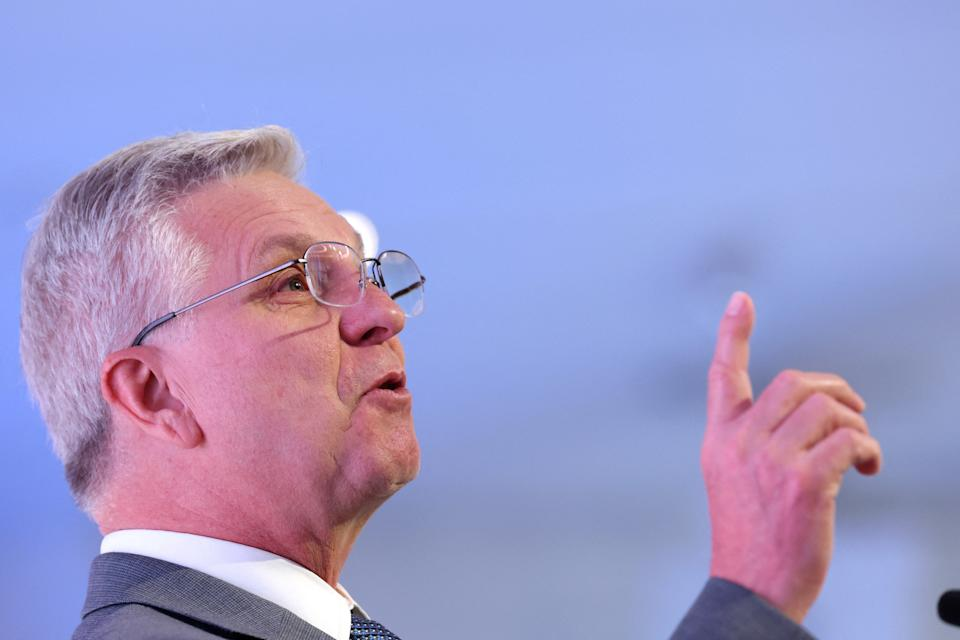
Waller makes strongest call yet for rate cut in July, underscoring Fed divide
Key Points
- Federal Reserve governor Christopher Waller strongly advocates for a rate cut at the upcoming July 29-30 policy meeting, suggesting a target rate of 3%, significantly lower than the current 4.25%-4.5%.
- Waller argues that inflation from tariffs is temporary and the Fed should focus on employment, citing slowing private sector job growth and increasing downside risks to the labor market.
- There is a divide within the Fed, with some officials like Adriana Kugler and John Williams opposing immediate rate cuts due to potential inflation from tariffs, expecting it to rise in the coming months.
- Waller’s stance aligns with President Trump’s push for lower rates, while Fed Chair Jerome Powell and others advocate for more time to assess inflation trends.
- The debate highlights opposing views within the Fed on how tariffs and economic data should influence monetary policy decisions.
Summary
Federal Reserve governor Christopher Waller has made a compelling case for a rate cut at the July 29-30 meeting, proposing a target rate of 3%, well below the current 4.25%-4.5%. Speaking in New York, Waller emphasized that inflation from tariffs is temporary and urged the Fed to prioritize employment, noting slowing private job growth and rising labor market risks. His position, supported by colleague Michelle Bowman and aligning with President Trump’s calls for lower rates, contrasts with other Fed officials like Adriana Kugler and John Williams, who caution against cuts due to potential inflation from tariffs, predicting increases through 2026. Fed Chair Jerome Powell also favors waiting for clearer inflation data, highlighting a deepening divide within the central bank. This debate underscores differing views on balancing inflation control with employment goals amid external pressures and tariff impacts.
yahoo
July 18, 2025
Stocks

Uber, Lucid partner on new robotaxi service, taking on Waymo and Tesla
Key Points
- Uber, Lucid, and Nuro have partnered to launch a next-generation premium global robotaxi program exclusively for the Uber platform, featuring the Lucid Gravity SUV equipped with Nuro’s Level 4 autonomous software.
- Uber plans to deploy 20,000 or more Lucid EVs over the next six years, with the service expected to launch in a major US city in 2025, and will invest $300 million in Lucid and a similar amount in Nuro.
- Lucid’s stock surged nearly 30% following the announcement, reflecting strong market confidence in the partnership and the company’s autonomous vehicle potential.
- This initiative marks Uber’s return to robotaxi services after halting its own operations following a 2018 accident, and it follows competition from Waymo and Tesla in the autonomous driving space.
Summary
Uber has teamed up with electric vehicle manufacturer Lucid and autonomous tech firm Nuro to introduce a premium global robotaxi program exclusively for the Uber platform. Announced recently, the initiative will integrate Nuro’s Level 4 autonomous software into Lucid’s Gravity SUV, with plans to deploy over 20,000 vehicles in the next six years, starting in a major US city in 2025. Uber will invest $300 million in Lucid and a comparable sum in Nuro, while the vehicles will be managed by Uber or third-party fleet partners. Lucid’s stock jumped nearly 30% on the news, bolstered by the company’s strong Q2 deliveries and ambitious 2025 production goals for its Air sedans and Gravity SUVs. This partnership signifies Uber’s re-entry into the robotaxi market after a hiatus following a 2018 accident, positioning it against competitors like Waymo and Tesla, who are also advancing in autonomous driving. The collaboration is further contextualized by Saudi Arabia’s Public Investment Fund’s significant stakes in both Uber and Lucid, potentially influencing the strategic alliance. A prototype is already under testing at Nuro’s Las Vegas facility, marking a significant step toward realizing the vision of accessible, safe autonomous transport.
yahoo
July 17, 2025
Stocks
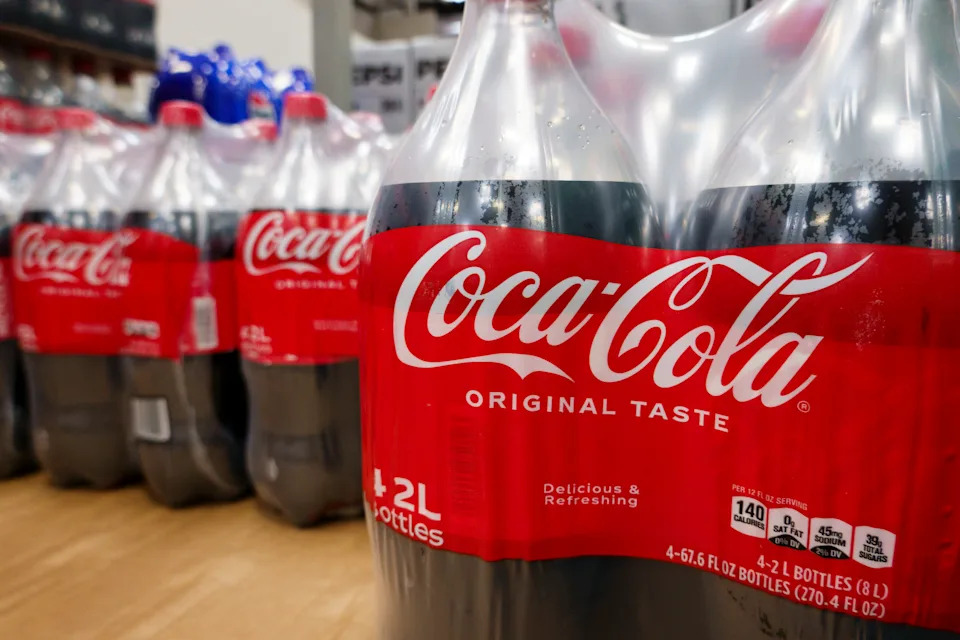
Coca-Cola says it appreciates Trump's 'enthusiasm' after president says company will use real sugar in drinks
Key Points
- Coca-Cola (KO) to Switch Ingredients: Coca-Cola is set to transition from high fructose corn syrup (HFCS) to real cane sugar in its U.S. products, following discussions with President Trump, as announced on social media.**
- Market Reactions: Sugar futures (Sugar No. 11, SB=F) rose over 1.3%, while HFCS suppliers like Archer-Daniels-Midland (ADM) and Ingredion (INGR) saw share declines of over 2.7% and 5%, respectively.**
- Competitor Response: PepsiCo (PEP), a major rival, reported a 5% stock increase after strong quarterly earnings and discussed plans to eliminate artificial colors and flavors in beverages.**
- Tariff Implications: The Trump administration's tariff negotiations, including a 50% tariff on Brazilian goods, may impact sugar supply chains, with Brazil being the top global sugar cane producer.**
Summary
Coca-Cola (KO) is poised to switch from high fructose corn syrup (HFCS) to real cane sugar in its U.S. products, following President Trump’s social media announcement and subsequent confirmation from the company. This move aligns with a broader trend among food and beverage companies like Kraft Heinz and General Mills making ingredient changes under the Trump administration. The shift has impacted markets, with sugar futures (Sugar No. 11) rising over 1.3%, while HFCS suppliers Archer-Daniels-Midland (ADM) and Ingredion (INGR) saw significant stock declines. Meanwhile, PepsiCo (PEP) reported strong earnings, with its stock up 5%, and outlined plans to remove artificial additives from beverages. The announcement coincides with ongoing tariff negotiations, including a 50% tariff on Brazilian goods, which could affect sugar supply chains given Brazil’s status as the world’s top sugar cane producer. Coca-Cola’s stock remained relatively stable, with quarterly earnings expected on July 22. This ingredient change reflects both consumer health trends and political influences, potentially reshaping the competitive landscape for beverage giants and their suppliers.
yahoo
July 17, 2025
Stocks

Retail sales rise more than expected in June
Key Points
- Retail sales in June increased by 0.6%, surpassing economists' expectations of a 0.1% rise, following a 0.9% decline in May.
- The control group, which impacts GDP readings, rose by 0.5% in June, compared to a 0.2% increase in May, exceeding forecasts of 0.3%.
- Sales excluding auto and gas also grew by 0.6% in June, doubling the expected 0.3% rise, with significant gains in miscellaneous store retailers (1.8%) and motor vehicle sales (1.2%).
- Economists suggest that delayed tariff price increases and steady income growth are supporting consumer spending, despite concerns over tariff uncertainty affecting future economic activity.
- Jobless claims dropped to 221,000 for the week ending July 12, the lowest in three months, while investor expectations for Federal Reserve rate cuts in September fell to 54% from 70%.
Summary
Retail sales in June showed a robust rebound, rising 0.6% month-over-month, exceeding economists’ predictions of a 0.1% increase and recovering from a 0.9% drop in May, according to revised Census Bureau data. This growth, particularly a 0.5% rise in the control group impacting GDP and a 0.6% increase in sales excluding auto and gas, suggests that President Trump’s tariffs have not yet significantly altered consumer spending patterns. Economists like Thomas Ryan from Capital Economics note that these figures dispel fears of faltering consumer spending due to tariffs, while Nationwide’s Ben Ayers highlights that delayed tariff price impacts and steady income growth continue to drive spending despite household concerns. Key sectors like miscellaneous store retailers and motor vehicle sales led the gains. Meanwhile, jobless claims fell to a three-month low of 221,000, indicating labor market resilience. However, tariff uncertainty looms over the economic outlook for the second half of the year, with expectations for weaker activity despite a projected solid GDP rebound in Q2. Investor sentiment on Federal Reserve rate cuts has also cooled, with the likelihood of a September cut dropping to 54% from 70%, amid signs of persistent inflation. This retail sales report offers critical insight as markets assess the broader impact of trade policies on economic behavior.
yahoo
July 17, 2025
Stocks

Republican senators caution Trump against firing Fed chair Jerome Powell
Key Points
- GOP Support for Powell: Some Republican senators, including Thom Tillis and Mike Rounds, are backing Federal Reserve Chair Jerome Powell, warning that firing him could undermine the Fed’s independence and destabilize the U.S. economy.**
- Trump’s Threats: President Donald Trump has fluctuated on whether to dismiss Powell, with some far-right House members encouraging the move, despite legal and economic concerns.**
- Legal Constraints: Firing the Fed chair is legally complex, as the position is protected from political pressure, requiring a “for cause” justification, which some argue is not met by current criticisms like the Fed’s renovation project.**
- Economic Risks: Senators like Tillis highlight that removing Powell could harm everyday Americans with investments like 401ks, while others stress the importance of an independent central bank for market confidence.**
Summary
Federal Reserve Chair Jerome Powell is receiving unexpected support from some GOP senators amid President Donald Trump’s threats to fire him. Republicans like Thom Tillis and Mike Rounds caution that dismissing Powell would jeopardize the Fed’s independence, potentially destabilizing the U.S. economy and eroding market confidence. Trump’s indecision on the matter has sparked debate, with some far-right House members urging action, while others, including House Speaker Mike Johnson, question the legal authority to remove Powell. Established over a century ago, the Fed is insulated from political interference, with dismissal requiring a justified “cause,” a threshold some argue is unmet by criticisms like a $2.5 billion renovation project. While certain Republicans, like Ohio Sen. Bernie Moreno, criticize Powell’s leadership and support his removal, others warn of the economic fallout for ordinary Americans and the risk of lengthy legal battles. As Powell’s term nears its end next year, Trump may soon have the chance to appoint a new chair, but the current controversy underscores the delicate balance between political influence and central bank autonomy.
yahoo
July 17, 2025
Stocks
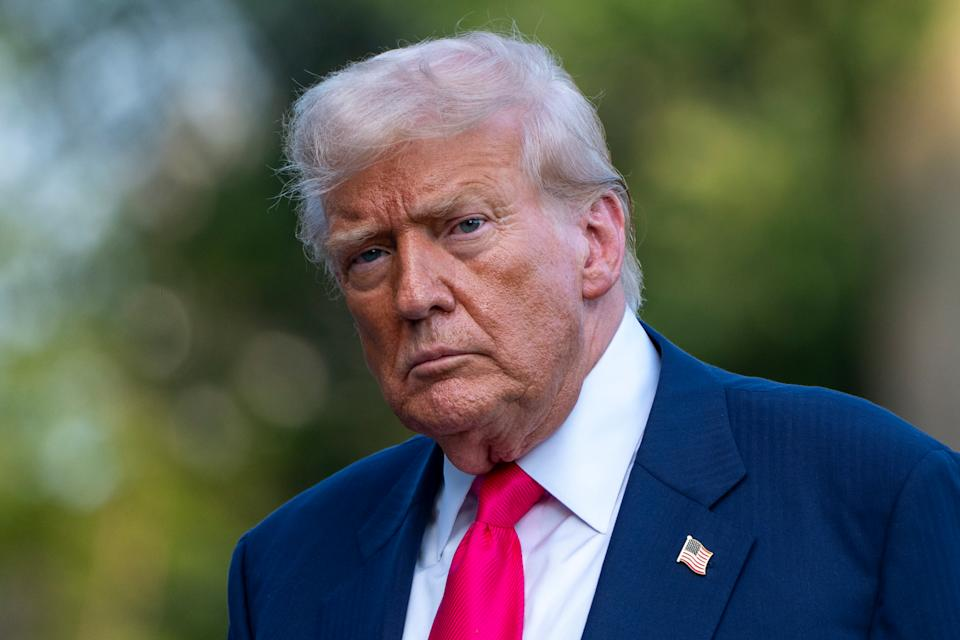
France Adds Support for Using Most-Potent Trade Tool on US
Key Points
- EU Response to US Tariffs: A growing number of EU member states, led by France, are pushing to use the EU's anti-coercion instrument (ACI) as a retaliatory measure if no agreement is reached with the US by August 1 and Donald Trump imposes threatened 30% tariffs on EU exports.**
- Potential Retaliatory Measures: The ACI could enable the EU to impose new taxes on US tech giants, restrict US investments, limit market access, or bar US firms from public contracts in Europe, potentially escalating a transatlantic trade war.**
- Negotiations Continue: Despite Trump's tariff threats, EU and US officials are engaged in ongoing talks, with EU trade chief Maros Sefcovic heading to Washington for further discussions, aiming for a negotiated outcome.**
- EU Caution on ACI Use: The European Commission, led by Ursula von der Leyen, considers the use of the ACI premature, emphasizing that it is reserved for extraordinary situations, while preferring proportional countermeasures and dialogue.**
Summary
A Bloomberg article highlights escalating trade tensions between the EU and the US as Donald Trump threatens 30% tariffs on EU exports by August 1, alongside existing duties on cars, steel, and aluminum. In response, a French-led coalition of over half a dozen EU member states advocates for deploying the anti-coercion instrument (ACI), a powerful trade tool that could impose retaliatory measures like taxes on US tech giants or restrictions on investments and market access. While negotiations continue, with EU trade chief Maros Sefcovic traveling to Washington, the European Commission deems ACI use premature, favoring dialogue and proportional countermeasures. French Minister Benjamin Haddad stresses the need for strength and unity in negotiations, warning of a potential transatlantic trade war if the ACI is activated. Despite Trump's escalating rhetoric, including threats on pharmaceuticals, EU officials remain focused on reaching a deal, previously hoping for a framework with a reduced 10% levy on most exports. The ACI, designed as a deterrent against coercive trade actions, reflects the EU's bolstered trade defenses post previous US tariffs and actions like China’s restrictions on Lithuania.
yahoo
July 16, 2025
Stocks
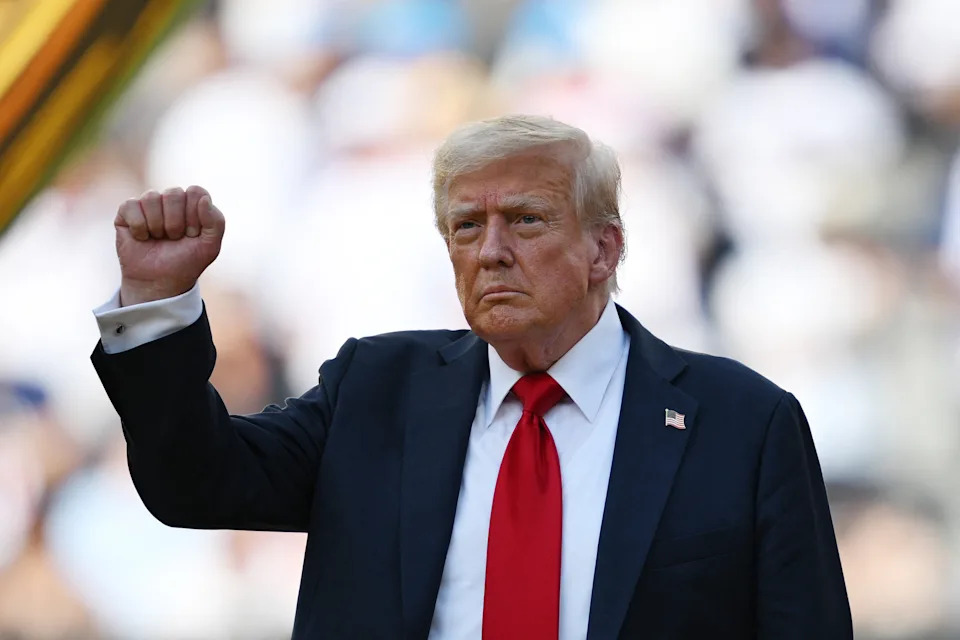
Markets are now ho-hum about tariff threats. Trump and Wall Street disagree about why.
Key Points
- White House View: The Trump administration believes market resilience to tariff threats indicates trader acceptance and support for rebalancing global trade, potentially encouraging President Trump to maintain his Aug. 1 deadline for new tariffs.**
- Market Skepticism: Many market observers argue that traders still oppose tariffs but are dismissive of Trump's latest threats, believing they may not materialize, reflecting a "Trump always chickens out" (TACO) sentiment.**
- Economic Risks: Critics and analysts, including JPMorgan Chase CEO Jamie Dimon, warn that markets may be underestimating the economic risks of tariffs, which could lead to higher interest rates, inflation, and a drag on growth.**
- Mixed Signals: While stock prices hit all-time highs, there’s a disconnect with tariff threats, and upcoming earnings seasons are expected to reveal the true impact of increased taxes on US companies.**
- Trade Developments: Ongoing trade talks and potential deals, like the recent one with Indonesia, add uncertainty, with Trump expressing indifference to outcomes with regions like the EU, potentially leading to higher tariffs.**
Summary
The article explores the conflicting interpretations of the stock market's muted response to President Trump's aggressive tariff threats. The White House sees this resilience as evidence of market support for rebalancing global trade, potentially emboldening Trump to stick to his Aug. 1 deadline for new tariffs. Conversely, many market analysts argue that traders remain opposed to tariffs but are skeptical of Trump’s threats materializing, a sentiment dubbed the "Trump always chickens out" (TACO) trade. Despite record-high stock prices, warnings from figures like JPMorgan Chase CEO Jamie Dimon highlight potential underestimation of economic risks, including inflation and growth slowdowns. Recent data showing a 2.7% annual CPI increase in June, alongside upcoming earnings reports, will provide further insight into tariffs’ impact. Trade developments, such as a deal with Indonesia reducing tariffs from 32% to 19%, add to the uncertainty, while Trump’s indifference to outcomes with regions like the EU raises the specter of higher tariffs. Critics argue the administration dismisses economic expertise, while Trump claims tariffs are fueling US economic strength, citing record stock highs and billions in tariff revenue. The coming weeks will be critical in determining whether markets are truly prepared for potential tariff-driven economic headwinds.
yahoo
July 16, 2025
Stocks
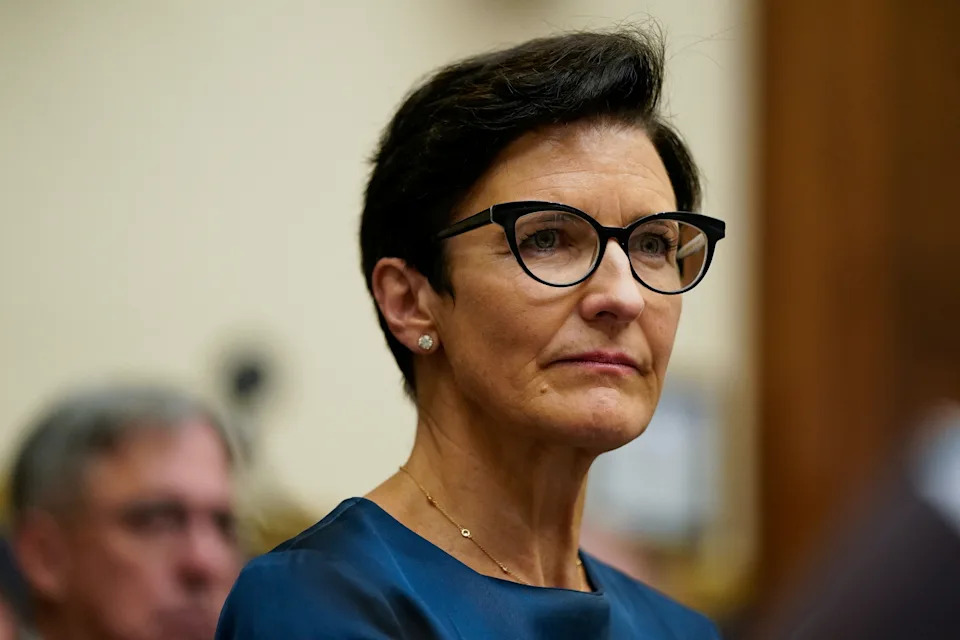
JPMorgan's Dimon and Citigroup's Fraser consider stablecoins in Wall Street crypto pivot
Key Points
- JPMorgan Chase and Citigroup CEOs, Jamie Dimon and Jane Fraser, announced plans to engage in stablecoin issuance, signaling Wall Street's growing acceptance of digital assets.
- Legislative efforts to regulate crypto, including stablecoins, faced setbacks as some GOP members blocked procedural votes in Congress during "Crypto Week."
- Major banks like Bank of America are also exploring stablecoin opportunities, anticipating federal approval and potential disruption of traditional payment systems.
- Proposed stablecoin legislation includes strict oversight, reserve requirements, and public disclosure mandates to ensure stability and transparency.
- Concerns persist about stablecoin risks, such as investor panic runs, despite their potential to enhance cross-border transactions and reduce crypto volatility.
Summary
Major Wall Street banks, including JPMorgan Chase and Citigroup, are pivoting toward digital assets as CEOs Jamie Dimon and Jane Fraser announced plans to issue stablecoins, reflecting a broader industry shift. This comes amid ongoing legislative debates in Congress, where efforts to pass comprehensive crypto regulation, including a federal framework for stablecoins, hit obstacles during "Crypto Week" due to GOP opposition to separate bill votes. Despite Dimon's historical skepticism, JPMorgan is developing a deposit token, while Bank of America and others explore collaborative stablecoin networks. The proposed legislation, already passed by the Senate, imposes strict oversight by federal and state regulators, mandates reserves in cash or Treasurys, and requires transparency. Stablecoins are touted for their stability and potential in cross-border payments, though concerns about risks like investor runs remain. Fraser noted that most stablecoin transactions currently settle crypto trades, with minimal use in payments. As banks prepare for potential federal approval, stablecoins could challenge traditional payment systems like Visa and Mastercard, reshaping financial landscapes if legislation advances.
yahoo
July 16, 2025
Stocks

Inflation accelerates in June as investors eye tariff-related price increases
Key Points
- Inflation Increase: The Consumer Price Index (CPI) rose 2.7% annually in June, up from 2.4% in May, driven by a reversal in falling gas prices, while core CPI, excluding food and energy, increased 2.9% year-over-year.**
- Tariff Impact Emerging: Signs of President Trump's tariffs affecting consumer prices are appearing, with increases in apparel (0.4%), footwear (0.7%), and furniture (0.4%), though the full impact may take time to materialize.**
- Trade Tensions: New tariffs ranging from 15% to 50% on imports from over 20 countries, including Canada, Mexico, and the EU, have heightened trade tensions, raising questions about inflation persistence.**
- Federal Reserve Uncertainty: Markets expect the Fed to hold rates steady in the near term due to tariff-related uncertainties, with the odds of a September rate cut dipping below 60%.**
- Shelter and Food Prices: Shelter costs, a major inflation driver, eased slightly to a 3.8% annual increase, while food prices remained sticky, though egg prices dropped 7.4% month-over-month.**
Summary
Inflation rose in June, with the Consumer Price Index (CPI) increasing 2.7% annually, up from 2.4% in May, driven by rebounding gas prices, according to the Bureau of Labor Statistics. Core CPI, excluding volatile food and energy, climbed 2.9% year-over-year. Monthly price increases matched or slightly exceeded expectations, with apparel, footwear, and furniture showing gains, hinting at the early effects of President Trump’s newly imposed tariffs ranging from 15% to 50% on imports from over 20 countries, including Canada, Mexico, and the EU. These trade tensions have sparked concerns about persistent inflation, though experts like Seema Shah and Greg Daco suggest tariff impacts may be temporary but could accelerate if staggered over time. Shelter costs, a key inflation driver, moderated slightly, while food prices remained sticky, except for a notable drop in egg prices. Amidst this, the Federal Reserve faces uncertainty, with markets anticipating steady rates in the near term and a reduced likelihood of a September cut. The interplay of tariffs and inflation continues to shape economic outlooks, with potential cost pass-throughs to consumers still unfolding.
yahoo
July 15, 2025
Stocks
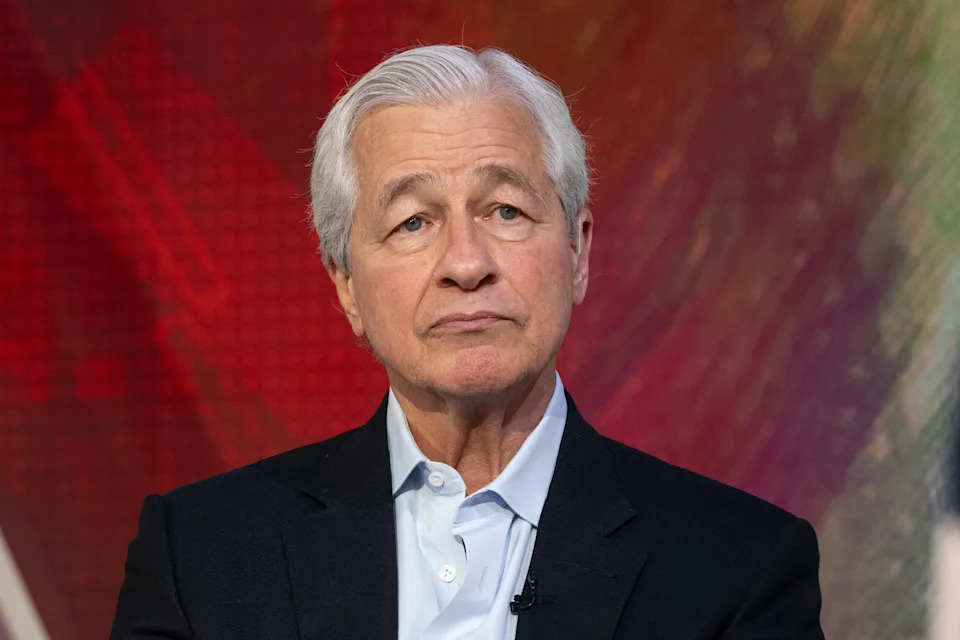
JPMorgan gets a dealmaking boost as Wall Street recovered from tariff tumult
Key Points
- JPMorgan Chase reported better-than-expected second-quarter earnings, with investment banking revenue up 8% to $2.5 billion, driven by mergers and equity underwriting.
- Total net income for the quarter was $15 billion, a 17% drop from last year due to a one-time Visa share gain in 2023, though adjusted profits rose 9% to $14.2 billion.
- CEO Jamie Dimon noted improved market sentiment and a resilient U.S. economy, while cautioning about risks from tariffs, trade uncertainty, and geopolitical issues.
- Trading revenue increased by 8% to $8.9 billion, and the bank raised its full-year net interest income guidance by $1 billion to $95.5 billion.
- Other banks like Wells Fargo and Citigroup also saw investment banking fee increases of 10% and 13%, respectively, reflecting a broader industry recovery.
Summary
JPMorgan Chase exceeded expectations in its second-quarter earnings, reporting a net income of $15 billion, despite a 17% year-over-year decline influenced by a one-time Visa share gain in 2023. Adjusted profits, however, rose 9% to $14.2 billion. Investment banking revenue grew 8% to $2.5 billion, fueled by mergers and equity underwriting, while trading revenue also increased 8% to $8.9 billion. CEO Jamie Dimon highlighted a slow start that gained momentum with improving market sentiment and a resilient U.S. economy, though he warned of risks from tariffs, trade uncertainty, and geopolitical tensions. The bank raised its full-year net interest income forecast by $1 billion to $95.5 billion. Meanwhile, other major banks like Wells Fargo and Citigroup reported investment banking fee growth of 10% and 13%, respectively, signaling a sector-wide recovery from earlier market gloom caused by President Trump’s "Liberation Day" tariffs. Despite volatility, Wall Street trading desks benefited from increased investor activity. JPMorgan’s stock remained flat, while Wells Fargo’s dropped over 4% after lowering its 2025 guidance, and Citigroup saw a slight uptick. This earnings season reflects cautious optimism as dealmaking rebounds and regulatory constraints ease under the Trump administration.
yahoo
July 15, 2025
Stocks

June inflation expected to show tariff-driven uptick as Trump escalates trade threats
Key Points
- June's Consumer Price Index (CPI) is projected to show a year-over-year increase of 2.6%, up from 2.4% in May, with a monthly rise of 0.3% compared to 0.1% previously.
- Core CPI, excluding food and energy, is expected to rise 2.9% annually and 0.3% monthly, indicating a slight acceleration from May's figures.
- Economists anticipate a reversal in falling car and apparel prices, potentially driving core inflation higher, amid concerns over the impact of President Trump's proposed tariffs.
- New tariffs ranging from 15% to 50% on imports from various countries, including Canada, Mexico, and the EU, are raising questions about future inflation and Federal Reserve rate decisions.
- Analysts from Wells Fargo, Bank of America, and Goldman Sachs predict a gradual increase in core goods inflation due to tariffs, though broader inflation pressures may ease later in the year.
Summary
The upcoming June Consumer Price Index (CPI) report, set for release on Tuesday, is expected to reflect a faster pace of inflation, with a projected year-over-year rise of 2.6% compared to 2.4% in May, and a monthly increase of 0.3%. Core CPI, excluding volatile food and energy prices, is forecasted to edge up to 2.9% annually. This comes as President Trump’s proposed tariffs, ranging from 15% to 50% on imports from countries like Canada, Mexico, and the EU, raise concerns about their impact on consumer prices. Economists note a potential reversal in declining car and apparel prices, which could push core inflation higher. Amid renewed trade tensions, the Federal Reserve’s rate-cutting path remains uncertain, though markets expect rates to hold steady for now. Analysts from Wells Fargo, Bank of America, and Goldman Sachs suggest tariffs will likely contribute to a gradual rise in core goods inflation, driven by factors like rebounding used car prices and broader cost increases. However, they anticipate limited pass-through to consumers and expect inflation pressures to cool later in the year due to softening housing and labor market dynamics. The June CPI data is seen as a critical indicator of whether inflation is strengthening, though not yet at a level to alarm Fed officials.
yahoo
July 15, 2025
Stocks

Nvidia to resume sales of AI chip to China as CEO visits Beijing
Key Points
- Nvidia plans to resume sales of its H20 AI chip to China, filing applications with the U.S. government for licenses, which it expects to receive soon.
- The company has faced U.S. export controls due to national security concerns, resulting in a $15 billion revenue loss and a $5.5 billion inventory write-off.
- Nvidia introduced a new AI chip, the RTX Pro GPU, designed to comply with U.S. export regulations for the Chinese market.
- CEO Jensen Huang emphasized the importance of the Chinese market during his visit to Beijing, highlighting its size, dynamism, and innovation.
- Despite easing U.S.-China tensions, Chinese companies are diversifying supply chains to mitigate risks from ongoing uncertainties.
Summary
Nvidia announced plans to resume sales of its H20 AI chip to China, following U.S. export restrictions that previously halted sales due to national security concerns, costing the company $15 billion in revenue and a $5.5 billion inventory write-off. The company is seeking U.S. government licenses to restart deliveries and has developed a new, compliant AI chip, the RTX Pro GPU, for the Chinese market. CEO Jensen Huang, visiting Beijing, underscored China’s critical role as a massive and innovative market during a supply chain expo. Despite facing competition from Chinese firms like Huawei and ongoing geopolitical uncertainties, Nvidia remains committed to the region, which accounted for 13% of its $17 billion revenue last fiscal year. Huang’s visit coincides with easing U.S.-China tensions, including relaxed rare earth export controls by China and resumed U.S. chip design software services. However, U.S. senators have urged caution regarding engagements with Chinese military or intelligence-linked entities. Analysts note that while the H20 ban pause offers relief, Chinese companies are diversifying supply chains to safeguard against future disruptions.
Anne Marie Roantree and Che Pan
July 15, 2025
Stocks
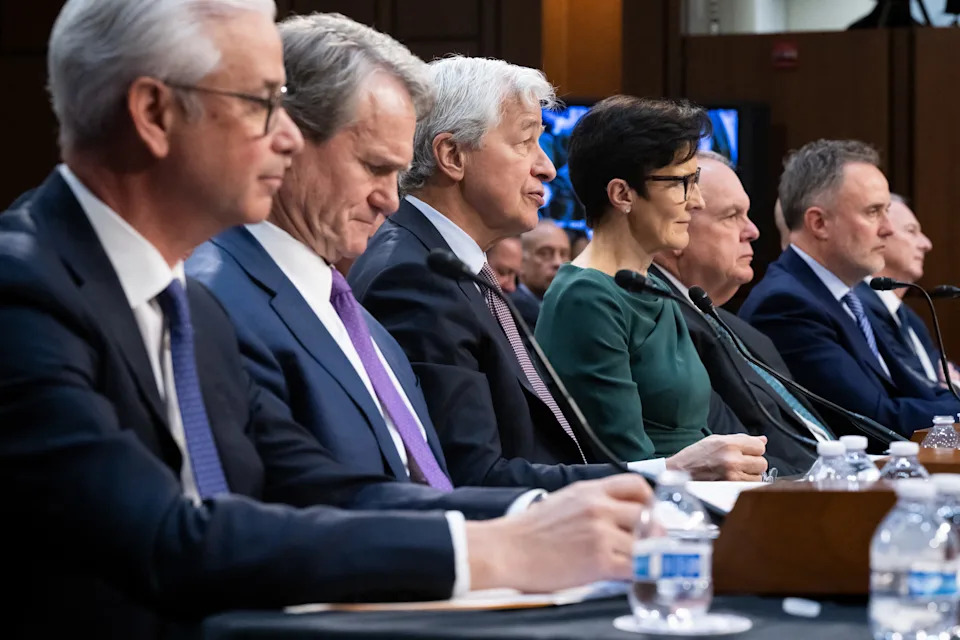
Big banks are trying to put Trump tariff tumult in their rear-view mirror
Key Points
- Optimism Replaces Gloom: The mood around major U.S. banks has shifted from pessimism to cautious optimism as they approach the new earnings season, following a challenging first quarter marked by market uncertainty and tariff-related volatility.**
- Strong Market Performance: Recent successful IPOs, mergers, and loosened capital rules by the Trump administration have bolstered the banking sector, with trading desks benefiting from market volatility.**
- Record Highs and Investor Confidence: After passing Federal Reserve stress tests, many big banks announced stock buybacks and dividends, leading to record-high stock prices for JPMorgan, Goldman Sachs, and Morgan Stanley on July 3.**
- Anticipated Earnings Beats: Analysts predict that banks like JPMorgan and Goldman Sachs may exceed previous investment banking guidance due to a strong recovery in the latter half of the quarter.**
Summary
The atmosphere surrounding the nation's largest banks has transformed from gloom to measured optimism as they head into the latest earnings season, starting with reports from JPMorgan Chase, Wells Fargo, and Citigroup. Three months ago, the sector faced uncertainty due to a dealmaking freeze and market turmoil following President Trump's "Liberation Day" tariff announcement. However, recent developments, including successful IPOs, mergers, and relaxed capital rules from the Trump administration, have revitalized the industry. Market volatility has even benefited trading desks, while stock buybacks and dividends post-Federal Reserve stress tests have driven investor enthusiasm, with JPMorgan, Goldman Sachs, and Morgan Stanley hitting record highs on July 3. Analysts are optimistic, predicting that some banks may surpass investment banking guidance, reflecting a strong recovery in the quarter's latter half. Investors are eager to hear confirmation that the challenges of April are behind and that the positive momentum will continue.
yahoo
July 14, 2025
Stocks
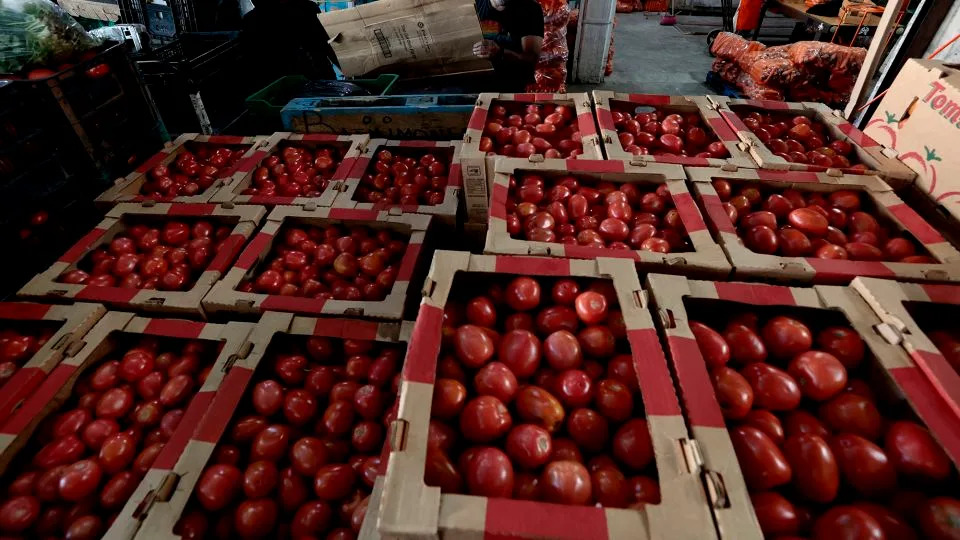
US tomato prices could jump as soon as Monday amid Mexico tariff threat
Key Points
- Tomato Tariffs Threaten Businesses: New 20.9% tariffs on Mexican tomato imports, set to replace a long-standing US-Mexico trade agreement on July 14, could drive up prices, risking bankruptcy for small businesses like Teresa Razo’s Argentine-Italian restaurants in Southern California.**
- Consumer Impact: Tomato prices for US consumers, currently around $1.70 per pound, may increase by about 10%, potentially reducing demand by 5%, according to agribusiness professor Timothy Richards.**
- Trade Policy Controversy: The tariffs, part of President Trump’s unpredictable trade policies, aim to combat “dumping” of cheap Mexican tomatoes, though Mexican growers argue the agreement has been largely upheld and violations are minimal.**
- Mixed Business Strategies: While some companies like Heinz and DiGiorno avoid tariffs by using US-grown tomatoes, others like Appollonia’s Pizzeria may absorb costs or switch suppliers seasonally, adding to operational stress.**
Summary
The impending 20.9% tariffs on Mexican tomato imports, set to replace a nearly three-decade-old US-Mexico trade agreement on July 14, are causing alarm among US businesses and consumers. Restaurant owner Teresa Razo fears bankruptcy for her Southern California eateries within three months due to rising costs, as tomatoes are essential for her dishes. Consumer prices, currently at $1.70 per pound, could jump by 10%, potentially curbing demand. The tariffs, part of President Trump’s erratic trade policies, aim to protect US growers from “dumping” by Mexican producers, though Mexican growers like Walberto Solorio argue the agreement has been mostly honored. US growers, represented by Robert Guenther, claim the tariffs are overdue to safeguard domestic markets. Businesses face varied impacts: some, like Heinz, use domestic tomatoes and avoid tariffs, while others, like Appollonia’s Pizzeria, may absorb costs or juggle suppliers. The uncertainty breeds “instability” and “fear” among small business owners like Razo, who are bracing for price hikes or sourcing alternatives amidst a chaotic trade landscape.
yahoo
July 14, 2025
Stocks

Trump tariffs live updates: Canada, EU, Mexico set to be hit with 30% to 35% rates as Trump amps up threats
Key Points
- Trump's Tariff Agenda: President Trump is implementing new tariffs starting in August, with rates ranging from 15% to 50% on goods from various countries, including 35% on Canada, 30% on Mexico and the EU, and 50% on Brazil and copper imports.**
- Impact on Trade Partners: Over 20 trade partners received tariff letters, with specific deals like Vietnam facing a 20% tariff (down from a threatened 46%) and potential reductions for India below 20% under a framework deal.**
- EU Response: The EU has delayed retaliatory tariffs on $24.5 billion of US exports until early August to negotiate with the Trump administration after a 30% tariff threat, aiming for a resolution.**
- Economic Fallout: Tariffs are affecting industries and companies, such as the closure of Michigan’s Howard Miller Co. due to increased costs, and creating uncertainty in sectors like tech and coffee with potential price hikes and supply chain disruptions.**
- Global Reactions: Leaders like German Chancellor Friedrich Merz warn that tariffs could severely impact export industries, while markets remain jittery over tariff risks and their broader economic implications.**
Summary
President Trump is advancing his tariff agenda, announcing new duties on imports starting in August, ranging from 15% to 50% across various countries. This includes 35% on Canadian goods, 30% on Mexico and the EU, and 50% on Brazilian goods and copper imports critical for power grids and tech. Over 20 trade partners received tariff letters, with Vietnam securing a reduced 20% rate and India potentially facing under 20% under a framework deal. The EU delayed retaliatory tariffs on $24.5 billion of US exports to negotiate a solution, while German leaders warn of severe impacts on export industries. The tariffs are already causing economic fallout, with Michigan’s nearly century-old Howard Miller Co. closing due to rising costs, and creating uncertainty in tech and coffee markets, where companies like Nvidia and Apple face additional pressures. Global markets remain nervous, with potential price increases and supply chain disruptions looming, as leaders and analysts grapple with the broader implications of Trump’s trade policies on economies and consumer wallets.
yahoo
July 14, 2025
Stocks
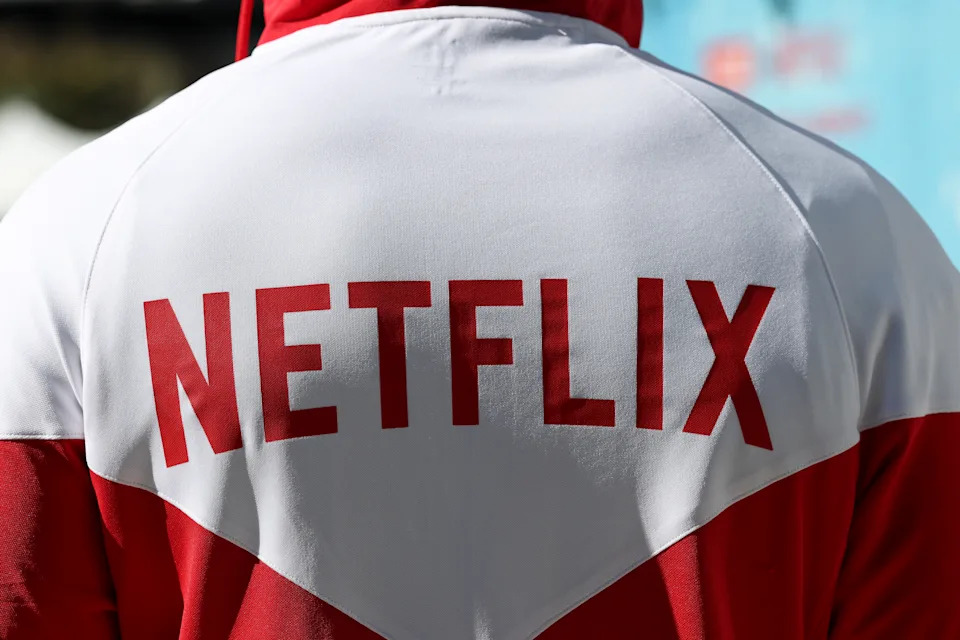
Inflation data, big bank earnings, and Netflix results: What to watch this week
Key Points
- Inflation Data: Tuesday's Consumer Price Index (CPI) release will be crucial for investors and policymakers, influencing the Federal Reserve's upcoming interest rate decision.**
- Earnings Season: Major US banks, Netflix, ASML, and Taiwan Semiconductor will report earnings, providing insights into banking, tech, and AI chip sectors.**
- Market Expectations: Analysts predict a 5% earnings growth for the S&P 500 in Q2, the slowest since Q4 2023, with stronger growth expected in Q3 (7.3%) and 2026 (13.9%).**
- Tariff Impact: Recent tariff announcements by Trump, including on Canada and higher blanket tariffs, have had minimal market disruption compared to earlier reactions.**
- Federal Reserve Outlook: Inflation data and tariff uncertainties are likely to keep the Fed on hold, with low odds (4.7%) of a rate cut this month despite Trump's calls for lower rates.**
Summary
Stocks are hovering near record highs despite a flurry of trade announcements and tariff policies under President Trump, which have had a muted impact on markets recently compared to earlier volatility. Key economic data, including Tuesday's Consumer Price Index (CPI), will shape expectations for the Federal Reserve's next interest rate decision, though inflation trends and tariff uncertainties suggest the Fed will remain cautious, with only a 4.7% chance of a rate cut this month. Earnings season kicks off with major US banks, Netflix, ASML, and Taiwan Semiconductor reporting, offering insights into banking, tech, and the AI chip boom. Analysts expect a modest 5% earnings growth for the S&P 500 in Q2, the slowest since late 2023, but anticipate stronger growth in Q3 (7.3%) and beyond. Wall Street has revised S&P 500 year-end targets upward, with Goldman Sachs at 6,600 and Bank of America at 6,300, driven by robust corporate earnings, especially in tech and communication sectors. Despite tariff-related challenges, market resilience and corporate strength continue to bolster investor confidence.
yahoo
July 13, 2025
Stocks